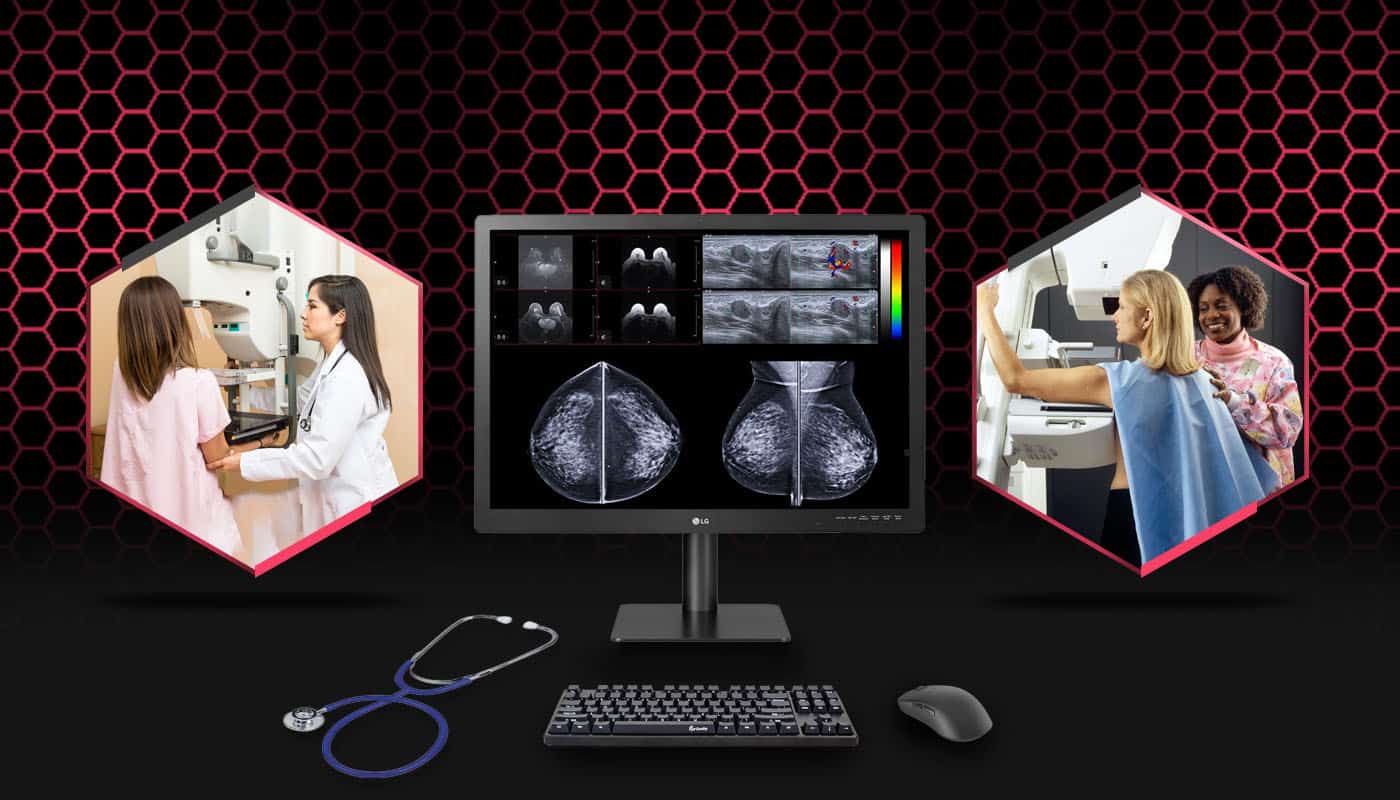- 17/09/2024
- by Miguel Sabater
Advantages of Medical Display Monitors in Mammography

Introduction
70% of diagnostic errors result from radiologists not seeing abnormalities within images.
Breast cancer is the most commonly missed diagnosis for radiologists.
Mammograms can be challenging to read because evidence of breast cancer is subtle. Masses, calcification, and a slight change in tissue density often blend into surrounding healthy tissues. As radiologists can attest, dense breast tissue appears white on a mammogram—but, unfortunately, so do cancers. The denser the patient’s breast tissue naturally is, the greater the challenge in identifying these indicators. Abnormalities need to be clearly visible to achieve earlier diagnoses and better patient outcomes.
The effectiveness of mammograms depends on the image quality. It also depends on what radiologists are able to see. So a better mammography display will yield a better reading.
The Importance of Screen Resolution in Medical Displays
Display brightness and screen resolution is the most important factor influencing the quality of breast images. This gives the ability for radiologists to detect abnormalities earlier in the development of medical conditions. This also contribute to the accuracy of diagnostic interpretation. Screen resolution impacts the sharpness and clarity of the image and, therefore, how many minute details can be seen.
What is resolution, exactly?
Resolution is defined in megapixels. A single megapixel represents one million pixels. To break it down, a pixel is simply the smallest part of an image—one dot. When combined, all the millions of individual pixels in an image form a complete picture. You can calculate total megapixels by multiplying the number of individual vertical pixels by the number of individual horizontal pixels, and then dividing that figure by one million.
Remember: The higher the resolution, the more elements are within an image, and the more details are visible on screen. And the more details mammography display can show, the better the reading radiologists can give.
Why 5MP (or higher) needed in Mammography
The American College of Radiology (ACR) and other industry organizations around the world recommend that the resolution of mammography displays should closely—if not precisely—match the resolution of the imaging system that captured the image under analysis. Because the resolution of breast imaging is so high, radiologists need at least 5MP—five million pixels—to reproduce them accurately on a screen and be able to view them 1:1, or at 100%, in full resolution.
If the display lacks sufficient resolution, which means that there are more elements in the breast image than available pixels on the screen, radiologists have to manipulate the image to view it at full-size resolution. This could involve panning, zooming, scaling, or windowing to achieve the best view of an image for analysis. This takes up a lot of time for radiologists. And, in the process, critical details within the image could be lost, which would have a negative impact on radiologists’ decisions and, ultimately, patient care.
But with a display that’s 5MP per screen or higher, radiologists can fit more of the mammogram within the display and see more detail with little to no image manipulation necessary. For radiologists who study about 40 images per day on average, this saves time and increases productivity.
Mammography displays that meet these requirements also provide ergonomic benefits that enhance radiologists’ comfort and ability to read images for longer periods.
Legal Requirements Under the Mammography Quality Standards Act (MQSA)
Clearly, higher-resolution mammography displays lead to more accurate diagnoses at earlier stages of disease progression, improve patient care and health outcomes, and enable a more comfortable, productive reading experience for radiologists. For these reasons, industry groups such as the ACR have set guidelines recommending displays of 5MP or higher.
Radiologists are also required by law to read cases on equipment that meets certain minimum standards. Alongside other region-specific laws passed by governments around the world, one of the most prominent and stringent pieces of legislation is the MQSA.
Passed by Congress in 1992 and overseen and enforced by the U.S. Food and Drug Administration (FDA), the MQSA establishes standards for image presentation on monitor screens. Part of this law mandates that each monitor in the typical dual-head display set-up have a screen size of 21 inches and a resolution of 5MP. (If you opt for a single fusion display, these monitors go up to 12MP and have screen sizes between 30 to 33 inches.)
Additionally, the MQSA requires mammography display monitors to undergo strict quality-assurance (QA) tests by qualified medical physicists as part of regular FDA inspections of mammography facilities. These QA tests focus on screen resolution, brightness, and contrast, and require that minimum standards for each be present in display monitors. Facilities must preserve the test results.
Ready to elevate your mammography imaging with LG’s cutting edge display technology?
Learn more about LG Medical Displays and how it can help your radiology practice improve accuracy and precision and eventually improve patient outcome.




Comments (12)
mr920 combat
05/02/2025 - 10:43 am… [Trackback]
[…] Information to that Topic: trucell.com.au/blog/advantages-of-medical-display-monitors-in-mammography/ […]
แทงบอลออนไลน์เกาหลี
20/02/2025 - 3:40 pm… [Trackback]
[…] Here you can find 97691 more Information on that Topic: trucell.com.au/blog/advantages-of-medical-display-monitors-in-mammography/ […]
Databet เว็บไซต์ที่ดีที่สุดสำหรับการเดิมพัน
21/02/2025 - 3:58 pm… [Trackback]
[…] Read More here to that Topic: trucell.com.au/blog/advantages-of-medical-display-monitors-in-mammography/ […]
KC9 คาสิโนออนไลน์ อันดับ 1
03/03/2025 - 6:42 pm… [Trackback]
[…] Read More on that Topic: trucell.com.au/blog/advantages-of-medical-display-monitors-in-mammography/ […]
essentials
11/03/2025 - 4:02 pm… [Trackback]
[…] Info on that Topic: trucell.com.au/blog/advantages-of-medical-display-monitors-in-mammography/ […]
https://draximene.com.br/pocket-option-strategy-spring-obzor-strategii/
12/03/2025 - 5:37 am… [Trackback]
[…] Info to that Topic: trucell.com.au/blog/advantages-of-medical-display-monitors-in-mammography/ […]
สมัคร คาสิโน SAGaming เว็บตรงมาแรงอันดับ 1 ต้อง Lsm99
17/03/2025 - 12:05 pm… [Trackback]
[…] Find More on to that Topic: trucell.com.au/blog/advantages-of-medical-display-monitors-in-mammography/ […]
Mostbet
20/03/2025 - 1:27 am… [Trackback]
[…] Read More on to that Topic: trucell.com.au/blog/advantages-of-medical-display-monitors-in-mammography/ […]
สั่งซื้อ หวยออนไลน์ มีกี่ช่องทาง
01/04/2025 - 1:51 pm… [Trackback]
[…] Read More Info here to that Topic: trucell.com.au/blog/advantages-of-medical-display-monitors-in-mammography/ […]
เว็บปั้มวิว
04/04/2025 - 3:04 pm… [Trackback]
[…] Find More on that Topic: trucell.com.au/blog/advantages-of-medical-display-monitors-in-mammography/ […]
เว็บตรงฝากถอนง่าย
06/04/2025 - 11:34 am… [Trackback]
[…] Here you can find 50474 additional Information on that Topic: trucell.com.au/blog/advantages-of-medical-display-monitors-in-mammography/ […]
ufa789
17/04/2025 - 10:04 am… [Trackback]
[…] Information to that Topic: trucell.com.au/blog/advantages-of-medical-display-monitors-in-mammography/ […]